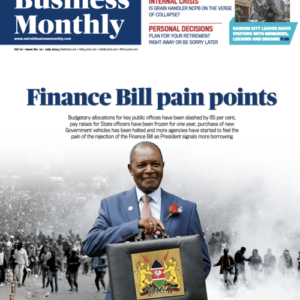By Perminus Wainaina
I recently met John, a business owner who had fully taken up his business functions to reduce over reliance on employees who under perform. He realized that everyone, including the management team, did not deliver results. There was need for accountability, initiative, and trust among the different departments.
He tried to salvage the situation by revising the salary for the employees, but it did not work. The team was still disengaged, and he spent much time firefighting and recruiting due to a high turnover instead of focusing on the core business. He was so frustrated that he wanted to fire and hire afresh.
Download Nairobi Business Monthly Latest Edition
This was when we came in to try and help him streamline his business. Unfortunately, below par performance is often overlooked. To drive up a team’s productivity, here’s what to consider:
Set clear key performance indicators for the team
When John returned to the organization, he did not take the time to help the team understand his expectations for them. The employees continued working as they did previously, thus producing the same results.
If John had taken time to show the team what he expected from them, how their role would support this vision to give them a sense of a shared sense of purpose and give them a clear path to take, it would have helped them to be on the same page and increase their productivity.
Encourage communication and feedback
John’s other mistake was only communicating what he wanted to be done and acting on what he thought would be helpful to the team from an uninformed point of view.
However, if he had encouraged his team to communicate and give feedback, he would have understood the gaps and provided help tailored to those gaps.
It could have been something simple as encouraging his staff to come to him with questions, concerns, and feedback on what was going on and streamlining communication for members to know where to get information when needed. Regular check-ins would have also helped stay in touch and ensure employees were engaged.
Invest in training and development of the team
When our clients reach out to us to provide training for their teams, and we do the training needs analysis, sometimes we may find that the client got it wrong when hiring, while others hire right, but there is still a need to update their skills and motivate their teams constantly.
For instance, if you promote employees to leadership positions, it can be helpful to train them in leadership and management training to empower them to lead with influence to get the best results from their leading teams.
Build trust in your team
Because there was no accountability across the board from staff to the managers, John’s employees were always quick to blame each other when something went wrong instead of taking responsibility or working together to find solutions.
However, suppose he had done team meetings or team-building activities? In that case, he could have helped build trust among members as it would have allowed workers to understand others’ personality traits, strengths, and weaknesses which would have encouraged them to work and complement each other.
On the other hand, it could have been helpful if John could have empowered the managers with decision-making ability to increase their sense of ownership and drive that to the rest of the team.
Finally, it is essential to remember to lead by example as your team is watching you lead the way to follow. Building a high-performing team requires more than bringing together talented people with the right skills. It involves a commitment to lead with influence, develop staff and nurture their skills and talent.
Writer is the CEO of Corporate Staffing Services, a HR consultancy firm based in Westlands.



